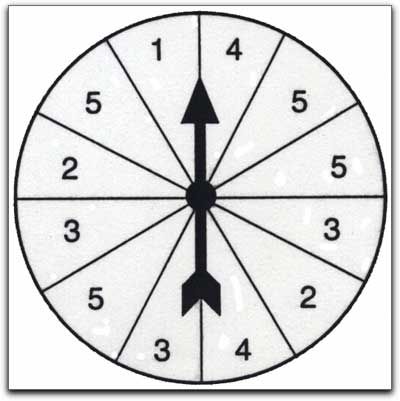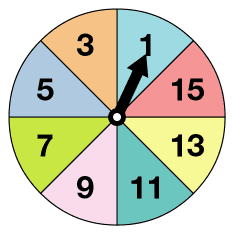Describe that Probability
Random Selection
Probability
Experimental Probability
Vocabulary
100
What is the likelihood of rolling an even number on a number cube?
Equally likely
100
State the sample space of tossing a plastic cup in the air.
Landing upside down, right side up, and on its side.
100
What is the probability of spinning a 5 as a fraction, decimal and a percent? Round to the nearest hundredths place if needed.




5/12= 0.41666.. = 41.7%
100
Darian made 24 of the 32 free throws he attempted. What is the experimental probability of him making the next shot written as a fraction, decimal, and percent? Round to the nearest hundredths place if needed.
24/32 = 0.75 = 75%
100
Define "theoretical probability."
It is the probability of what we expect to occur; no data is collected.
200
True or False: Likely is the same as 50% probability.
False
200
How many outcomes are there on the spinner?


8 total outcomes
200
A set of cards includes 15 yellow cards, 13 green cards, and 12 blue cards. Which card color has a probability of 3/10?
Probability of drawing a blue card
200
In a soccer shoot-out, Bryan made 4 out of 9 shots. What is the experimental probability that he will not make his next shot?
5/9 = 0.55... = about 56%
200
Define "experimental probability."
The probability of what actually occurs; probability is calculated after collecting data
300
What is the likelihood of spinning a 3?




What is likely?
300
Label the following as uniform or non-uniform probability:
A) Flipping a coin,
B) Selecting an odd number from numbers 1-13,
C) Picking a student from 10 sixth graders, 7 seventh graders, 7 eighth graders
Her prediction was higher than her actual results.
300
There are 8 green marbles, 7 blue marbles, and 6 red marbles in a jar. What is the probability of not drawing a red marble?
15/21 = 5/7
300
Bryan made 26 out of 50 free-throw attempts. If Bryan shoots the ball 100 times, about how many free-throws can you expect him to make?
52 free throws; P(making free throw) = 26/50 = 52/100
300
Define sample space.
All the possible outcomes of an experiment.
400
A spinner has 6 equal parts labeled 1-6. What is P(Greater than 2)? Describe the probability.
Likely (4/6 = 2/3)
400
Label the following as uniform or non-uniform probability:
A) Flipping a coin,
B) Selecting an odd number from numbers 1-13,
C) Picking a student from 10 sixth graders, 7 seventh graders, 7 eighth graders
A) Uniform, B) Non-uniform, C) Non-uniform
400
In the game of chess the pieces come in black and white. For each color, there are the following pieces:
1 - queen, king
2 - rooks, bishops, knights,
8 - pawns
What is the probability of randomly selecting a rook in simplest form?
4/32 = 1/8
400
If you spin the spinner 48 times, how many times can you expect to land on 11?




6
400
"Cameron hit 5 homeruns out of 10 swings in the Homerun Derby at his school. The probability of his next swing being a homerun is 1/2." Student A read this and said it's theoretical probability. Student B said it's experimental probability. Who is correct? Explain why.
Student B because the word problem has the data collected from Cameron performing the event (hitting baseballs). They calculated the probability based on the repeated experiment.
500
There are 3 green marbles, 2 red marbles and 15 blue marbles. Give a scenario that is unlikely to happen?
Draw a red marble OR draw a green marble
500
An airline food service finds that a recent flight of 120 passengers ordered dinner. 25 people ordered lasagna. Based on this data, how many lasagna dinners are likely to be needed for a flight with 360 passengers?
75 lasagna dinners; P(lasagna dinner ordered) = 25/120 = 75/360
500
In Ms. McCarthy's Language Arts class students created projects to share with the class. There are 10 boys and 15 girls. What is the probability of not drawing a boy to present first in decimal form? Write in percent form.
15/25 = 60/100 = 60%
500
Jason rolls a number cube 42 times. About how many times can he expect to roll an odd number GREATER THAN 1?
14 times; P(odd number greater than 1) = 2/6 = 14/42
500
Tell the difference between uniform and non-uniform probability.
Uniform probability has outcomes that all have the same probability of occurring. Non-uniform has outcomes that do not have the same probability of occurring (not all equally likely to occur).